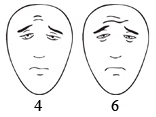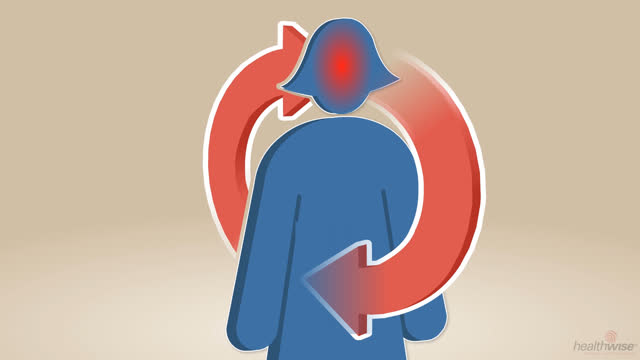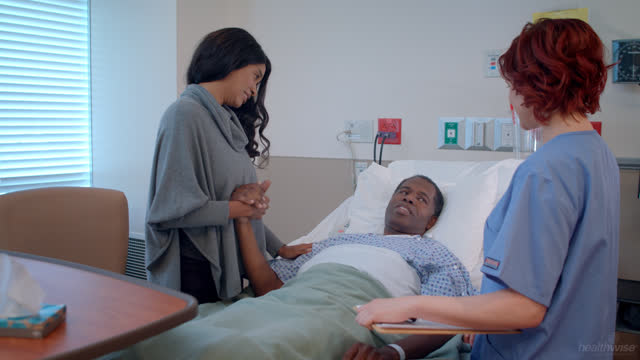Pain Management
Topic Overview
What is pain?
Pain is your body’s way of warning you that something is wrong. If you step on a sharp object or put your hand on a hot stove, the pain lets you know right away that you are hurt and need to protect yourself. You may have pain from an injury, after surgery, or from a health problem like cancer, osteoarthritis, low back pain, headaches, or fibromyalgia.
Your body feels pain through nerves in your skin and organs. These nerve endings send pain signals to your brain.
What are the different types of pain?
Pain can affect:
- Muscles, bones, and joints. It also affects the ligaments and tendons. This pain can happen from injuries or muscle strain. Health problems like osteoarthritis, rheumatoid arthritis, and fibromyalgia also can cause it.
- Nerves and the nervous system. This type of pain happens because of pressure on nerves or damage to them from an injury or a health problem. Sometimes pain occurs when something goes wrong with the central nervous system. Diabetes, shingles, and sciatica are examples of health problems that cause nerve pain.
- Organs. Pain in your organs occurs because of injuries, infections, or health problems such as cancer, inflammatory bowel disease, irritable bowel syndrome, pelvic pain, and stomach ulcers.
You can have more than one kind of pain at the same time. For example, cancer can cause pain in your bones and your organs.
Does all pain feel the same?
Pain feels different for everyone. Something that doesn’t bother one person might feel very bad to someone else.
Pain can feel sharp or dull. It may throb or burn. It may be in one part of your body, such as with a headache or a stomach ulcer. Or you may feel pain all over, like when your muscles ache from intense exercise or the flu.
Some pain may be so mild that you can ignore it until it goes away. But other pain may be so bad that you can’t do your daily activities without medicine or other treatment.
How long can pain last?
Pain may last for a short time or a long time. It may come and go or it may be constant.
Pain that starts quickly and lasts for a short time is called acute pain. Examples include pain from an injury, a headache, childbirth, or right after surgery.
Pain that goes on for months or years is called chronic pain. You may have this pain from an injury that doesn’t heal or from a health problem like low back pain, very bad headaches, or diabetic neuropathy.
Health Tools
Health Tools help you make wise health decisions or take action to improve your health.
- Anxiety: Stop Negative Thoughts
- Depression: Stop Negative Thoughts
- Stop Negative Thoughts: Getting Started
- Stress Management: Breathing Exercises for Relaxation
- Stress Management: Doing Guided Imagery to Relax
- Stress Management: Doing Meditation
- Stress Management: Doing Progressive Muscle Relaxation
- Stress Management: Managing Your Time
- Stress Management: Practicing Yoga to Relax
Reasons to Control Pain
Controlling your pain can help you to:
- Be active.
- Sleep.
- Cope better with your treatment for a health problem.
- Enjoy family and friends.
- Eat with pleasure.
- Heal faster after an injury or surgery.
Long-term pain that isn’t controlled can take the joy from your life. You may not be able to work. Physical activity may be too painful or exhausting. You may have a hard time sleeping at night, which can make you tired and cranky. Your outlook on life may change and strain your relationships with family and friends. You may become depressed and anxious. Controlling pain can help with all these things.
Treatment
Many different treatments can ease pain. Medicines are the most common treatment. But to feel better, you will need to do more than take medicine, such as reducing your stress level or changing how you think.
You also can try physical therapy, relaxation, acupuncture, and other ways to feel better. Talk with your doctor about what mix of treatments might work best for you.
Your treatment depends on several things, including:
- How bad your pain is (based on what you tell your doctor).
- How long you’ve had pain.
- The type of pain you have. For example, you might take different medicine for joint pain than you would for nerve pain.
- Other health problems you may have.
If you have pain for a long time, your treatment may change over time.
Medicines to treat pain
Medicines can help you get better and can even save your life. But they can also be dangerous, especially if you don’t take them the right way. Be safe with medicines. Read and follow all instructions on the label.
Several types of medicines can be used to treat pain. Most of these medicines can treat more than one kind of pain. So you may need to try a couple of medicines to see which works best for you. Your doctor will work with you to find the right types and dosage of medicine. You may take more than one kind of medicine at the same time.
|
Examples |
Types of pain |
|---|---|
|
Acetaminophen:
|
|
|
Corticosteroids:
|
|
|
Nonsteroidal anti-inflammatory drugs (NSAIDS):
|
|
|
Anticonvulsants:
|
|
|
|
|
Serotonin and norepinephrine reuptake inhibitor (SNRI) antidepressants:
|
|
|
Selective serotonin reuptake inhibitor (SSRI) antidepressants:
|
|
|
Tricyclic and tetracyclic antidepressants:
|
|
|
NMDA receptor antagonists:
|
|
All medicines have side effects. For more information, see the Side Effects of Pain Medicines section of this topic.
Learn more about:
- Which questions to ask about your medicines.
- How to take medicines as prescribed.
- How to get rid of medicines.
Other treatments
You may want to try other ways to help you relax and ease pain. These may include:
- Acupuncture. Very thin needles are put into the skin at certain places on your body to relieve pain.
- Biofeedback. You may use this to help control muscle tension, heart rate, and other reactions to pain.
- Heat or cold. These can help arthritis. You also can use heat or cold for sore muscles and other aches.
- Hypnosis. This may help you focus your mind on something other than your pain.
- Massage. This can reduce muscle tension.
- Meditation. This may help you focus your mind on something other than your pain. It also can reduce stress.
- Physical therapy. This treatment can improve how you move and your overall fitness.
- Transcutaneous electric nerve stimulation (TENS). A mild electrical current is used to relieve pain.
- Yoga. This may increase your strength and how well you move. It also can reduce stress.
For more information, see the topic Complementary Medicine.
Reducing stress
Stress can make pain worse. It can tighten your muscles, which can cause headaches and pain in your neck, shoulders, and back.
Try these methods to reduce stress and pain:
- Breathing exercises for relaxation
- Doing guided imagery to relax
- Doing meditation
- Doing progressive muscle relaxation
- Managing your time
- Reducing stress by being assertive
- Practicing yoga to relax
For more information, see the topic Stress Management.
Changing how you think
How you think can affect how you feel. You may be able to reduce your pain by stopping negative thoughts. You can change what you say to yourself about your pain. To help your outlook, try the methods described in these topics:
- Stop Negative Thoughts: Getting Started
- Anxiety: Stop Negative Thoughts
- Depression: Stop Negative Thoughts
For more information, see the topic Stop Negative Thoughts: Choosing a Healthier Way of Thinking.
Knowing When Pain Is Worse
Pain can get worse slowly. So it can be hard to tell if your pain is getting worse, especially if you’ve had it for a while. But you can look for signs that your pain is worse. You may notice that:
- You have new pain. The pain may be in a new area, or it may feel different.
- Your pain treatment no longer works, or it doesn’t work like it used to.
- Your medicine wears off too soon between each dose.
- Your pain gets in the way of daily activities such as eating and sleeping.
Using a pain scale and a pain diary can help you know how much pain you’re having. These tools also can help you tell your doctor what your pain feels like so that he or she can help you. You can use these tools for short-term or long-term pain.
Use a pain scale
Health professionals often use a pain scale to find out how much pain a person has. The scale is from 0 to 10, with “0” being no pain and “10” being the worst possible pain.
To use a pain scale, write down how strong your pain is and when it comes and goes.
Use a pain diary
Use a pain diary( What is a PDF document? ) to keep a record of your pain. Write down what pain medicines you’re taking and how well they are working.
Also write down anything else you’re doing to control your pain. Note the details of your pain so you can tell your doctor. Is it burning? Throbbing? Steady? How long does it last?
Take your diary and pain scale and any questions with you when you see your doctor. Talk to your doctor anytime you have new pain or your pain gets worse.
Side Effects of Pain Medicines
All medicines have side effects. But many side effects can be managed so that you can still take the medicine. Talk to your doctor if you have any side effects. Your doctor may change your dose or the type of medicine you take.
Examples of side effects of over-the-counter medicines
- Acetaminophen (Tylenol). This medicine may cause:
- Nausea.
- Rash.
- Liver damage (with high doses).
- Nonsteroidal anti-inflammatory drugs (such as Advil, Aleve, and Motrin). These may cause:
- Stomach upset, heartburn, and nausea. If the medicine upsets your stomach, you can try taking it with food. But if that doesn’t help, talk with your doctor to make sure it’s not a more serious problem.
- Stomach ulcers and kidney problems (with long-term use).
- Allergic reaction (rare).
- Increased risk of heart attack and stroke. These risks are greater if the medicine is taken at higher doses or for longer than recommended.
No one younger than 20 should take aspirin. It has been linked to Reye syndrome, a serious illness.
Examples of side effects of prescription medicines
- Anticonvulsant medicines. These may cause:
- Dizziness.
- Drowsiness.
- Fatigue.
- Headache.
- Confusion.
- Skin rash.
- Corticosteroids. These may cause:
- Nausea and vomiting.
- Swelling of hands and feet.
- Increased appetite.
- Increased risk of infection.
- Osteoporosis (with long-term use).
- Cataracts (with long-term use).
Because of the chance of side effects, doctors usually try to prescribe steroid medicines only for a short time.
- Opioid pain relievers. These may cause:
- Constipation.
- Dizziness, lightheadedness, or feeling faint.
- Drowsiness.
- Nausea or vomiting.
Opioid pain relievers are strong medicines. They can help you manage pain when you use them the right way. But if you misuse them, they can cause serious harm and even death. For these reasons, it is important to use them exactly as your doctor prescribes. But you can develop opioid use disorder. Moderate to severe opioid use disorder is sometimes called addiction. The risk is higher if you have a history of substance use. Your doctor will monitor you closely for signs of opioid use disorder and to figure out when you no longer need to take opioids. If you are worried about developing this disorder, talk with your doctor.
If you are taking a long-acting opioid pain reliever, make sure you know how to use it safely.
- Selective serotonin reuptake inhibitor (SSRI) antidepressants. These may cause:
- Nausea.
- Loss of appetite.
- Diarrhea.
- Anxiety.
- Sleep problems.
- Loss of sexual desire or ability.
- Headaches.
- Weight gain.
- Serotonin and norepinephrine reuptake inhibitor (SNRI) antidepressants. These may cause:
- Constipation.
- Cough.
- Dizziness.
- Dry mouth.
- Headache.
- Nausea and loss of appetite.
- Decrease in sexual desire or ability.
- Sleep problems.
- Weight loss.
- Tricyclic and tetracyclic antidepressants. These may cause:
- Blurred vision.
- Confusion.
- Constipation.
- Drowsiness and fatigue.
- Dry mouth.
- Loss of sexual desire or ability.
The U.S. Food and Drug Administration (FDA) has issued an advisory on antidepressant medicines and the risk of suicide. Talk with your doctor about these possible side effects and the warning signs of suicide.
For more information, see the topic Dealing With Medicine Side Effects and Interactions.
Following a Treatment Plan
The best way to control your pain is to follow your treatment plan and give it time to work. The goal of your treatment plan is to be able to function and do the things you need to do, even if you still have some pain.
Some treatments may take a few days or weeks to improve your pain. You and your doctor can talk about how long you should stay on a medicine or other treatment.
It’s very important to take your medicines exactly as your doctor prescribes. Following your doctor’s advice will help you get the right amount of medicine with as few side effects as possible. It also will help you and your doctor know if a medicine is working for you.
Make sure to tell your doctor about any medicines or herbal supplements you take. Your other medicines and supplements could mix in a bad way with your pain medicines. This could keep the pain medicine from working as well as it could.
Don’t wait for pain to get bad
Make the most of your pain medicines by following these rules:
- Take them on time (by the clock).
- Do not skip a dose or wait until you think you need it.
- Be prepared for breakthrough pain. You may find that taking your medicine works most of the time but that your pain flares up during extra activity or even for no clear reason. These flare-ups are called breakthrough pain. Your doctor can give you a prescription for fast-acting medicines that you can take for breakthrough pain.
- If you have more than one doctor, pick one doctor to be in charge of all your medicines. If more than one doctor prescribes pain medicine, make sure they talk to each other about it.
Learn more about:
When to Call Your Doctor
Only you can tell how much pain you have and whether it’s getting better or worse. Talk to your doctor anytime you have new pain, your pain gets worse, or your treatment isn’t controlling your pain.
Some people may think they’re weak if they tell their doctor about their pain. Or they worry that they’re bothering their doctor.
You’re not weak. And you’re not bothering the doctor. Your doctor wants to help you. But to help you, he or she needs to know how you really feel.
Call your doctor if:
- Your pain gets worse or is out of control.
- You have stomach pain, an upset stomach, constipation, or heartburn that lasts or comes back.
- You don’t get better as expected.
- You cannot sleep because of pain.
- You are very worried or anxious or are feeling sad about your pain.
- Your pain medicine isn’t working or you have trouble taking it.
For more information, see the topic Work Closely With Your Doctor.
Getting Support
Needing other people for emotional support is a normal part of life. You may have to lean on family and friends if you’re getting over an injury or surgery or if you live with pain much of the time.
It can be hard sometimes to ask for help. But don’t be afraid to reach out. Other people can help you—and they may be eager to help. Along with your family and friends, you can seek support from:
- Counseling. A professional counselor can help you cope with pain, stress, and things that happen in your life. Counseling can help you understand and deal with an illness.
- Your doctor. Find a doctor you trust and feel comfortable with. Be open and honest about your fears and concerns. Your doctor can help you get the right medical treatments, including counseling.
- Religious groups. Religious or spiritual groups may help you meet people and get involved in the community. Some religious groups can help you get counseling or other social support services.
- Social groups. You can meet new people and get involved in activities you enjoy.
- Community support groups. In a support group, you can talk to others who have dealt with the same problems you have. You can encourage each other and learn ways of coping with your feelings.
For more information, see the topic Support Groups and Social Support.
References
Other Works Consulted
- Washington State Department of Labor and Industries (2011). Work-Related Complex Regional Pain Syndrome (CRPS): Diagnosis and Treatment. Olympia, WA: Washington State Department of Labor and Industries. Available online: http://www.lni.wa.gov/ClaimsIns/Providers/TreatingPatients/TreatGuide/default.asp.
Credits
Current as ofMarch 28, 2019
Author: Healthwise Staff
Medical Review: Anne C. Poinier MD – Internal Medicine
E. Gregory Thompson MD – Internal Medicine
Adam Husney MD – Family Medicine
Martin J. Gabica MD – Family Medicine
Kathleen Romito MD – Family Medicine
Nancy Greenwald MD – Physical Medicine and Rehabilitation
Current as of: March 28, 2019
Author: Healthwise Staff
Medical Review:Anne C. Poinier MD – Internal Medicine & E. Gregory Thompson MD – Internal Medicine & Adam Husney MD – Family Medicine & Martin J. Gabica MD – Family Medicine & Kathleen Romito MD – Family Medicine & Nancy Greenwald MD – Physical Medicine and Rehabilitation
This information does not replace the advice of a doctor. Healthwise, Incorporated, disclaims any warranty or liability for your use of this information. Your use of this information means that you agree to the Terms of Use. Learn how we develop our content.







